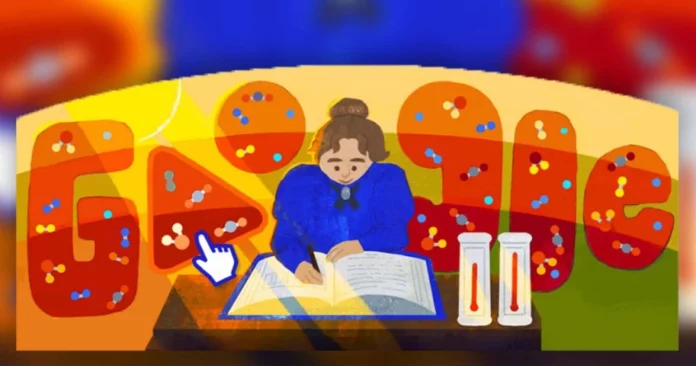Google Doodle Honors the 204th Birthday of American Climate Scientist, Eunice Newton Foote
Foote, credited with igniting interest in climate change, was the initial individual to uncover the greenhouse effect and its significance in the Earth’s warming climate.

On July 17th, Google honored the remarkable achievements of Eunice Newton Foote, an American scientist and advocate for women’s rights. Foote is renowned as the first person to uncover the greenhouse effect and its connection to the warming of Earth’s climate.
The Google Doodle dedicated to Foote on her 204th birthday features an interactive graphic comprising 11 slides. Through these slides, Google explains the concept of the greenhouse effect and highlights Foote’s significant contributions to the field of science.
While her passion for science persisted throughout her life, Foote also dedicated herself to advocating for women’s rights. Her pioneering work in the field of climate science is testament to her scientific curiosity and determination to advance knowledge.
Google’s tribute to Eunice Newton Foote serves as a recognition of her groundbreaking research and her contributions to the understanding of our planet’s climate. It also highlights her role as a trailblazer for women in both the scientific and social realms.
The greenhouse effect refers to the phenomenon where certain gases present in a planet’s atmosphere trap heat and prevent it from escaping into space. On Earth, this effect is crucial for maintaining a habitable temperature range. It occurs when greenhouse gases, such as carbon dioxide (CO2), methane (CH4), and water vapor (H2O), absorb and re-emit infrared radiation.

When sunlight reaches the Earth’s surface, it warms the planet. Some of this heat is radiated back into space as infrared radiation. However, greenhouse gases in the atmosphere absorb and re-emit some of this infrared radiation, trapping it within the atmosphere. This trapped heat increases the temperature of the planet’s surface and lower atmosphere, creating a warming effect similar to that inside a greenhouse.
Eunice Newton Foote’s pioneering work in the mid-19th century involved conducting experiments to investigate the temperature effects of different gases, including carbon dioxide. Her experiments revealed that carbon dioxide and water vapor had a greater capacity to absorb heat compared to the surrounding air. Foote’s research laid the groundwork for understanding the role of greenhouse gases in climate change and the potential impacts of human activities on global warming.
Today, the greenhouse effect and the associated climate change are topics of significant scientific and environmental concern, as human activities have led to an increase in greenhouse gas concentrations in the atmosphere. The understanding of the greenhouse effect is crucial for addressing and mitigating the impacts of climate change on our planet.
Eunice Newton Foote, born in 1819 in Connecticut, was a remarkable scientist and advocate for women’s rights. In 1848, she attended the historic Woman’s Rights Convention in Seneca Falls, where she became the fifth person to sign the Declaration of Sentiments. This document called for gender equality in social and legal aspects of life.
Despite facing societal barriers that limited women’s participation in scientific endeavors, Foote conducted her own experiments. In her research, she placed mercury thermometers inside glass cylinders and exposed them to sunlight. Through these experiments, she made a groundbreaking discovery. Foote found that the cylinder containing carbon dioxide experienced the most significant heating effect from the sun. This led her to establish a connection between increasing levels of carbon dioxide and the warming of the atmosphere—an early recognition of the greenhouse effect.
Foote’s research on the relationship between carbon dioxide and atmospheric warming laid the foundation for further investigations into climate change. Her work, although often overlooked during her time, has since been recognized as a significant contribution to the understanding of the Earth’s climate system.
In recognition of her scientific achievements and dedication to women’s rights, Google paid tribute to Eunice Newton Foote on her 204th birthday through an interactive Doodle. This serves as a reminder of her pioneering efforts and the importance of inclusivity in the field of science.
Sadly, Eunice Newton Foote passed away in 1888, and for nearly a century, her significant contributions to science remained unknown. It was not until the twentieth century that her work was rediscovered by women academics who recognized its importance. Foote’s groundbreaking findings on the greenhouse effect, published during her lifetime, paved the way for further research in climate science.
In addition to her work on the greenhouse effect, Foote also conducted studies on atmospheric static electricity, publishing two physics studies in the United States. Her research was pioneering, as she became the first woman to publish a physics study in the country. These discussions and experiments further contributed to our understanding of the greenhouse effect and its implications.
Today, scientists around the world continue to advance climate science, building upon the foundation laid by Eunice Newton Foote. Her contributions to our understanding of the Earth’s climate system are significant and have had a lasting impact. Through its Doodle tribute, Google celebrated Foote.
On July 17th, Google commemorated the accomplishments of Eunice Newton Foote, an American scientist and advocate for women’s rights, by featuring her in a Google Doodle on her 204th birthday. The interactive graphic displayed in the Doodle consists of 11 slides that explain the concept of the greenhouse effect and highlight Foote’s significant contributions to science.

Foote’s passion for science remained steadfast throughout her life, and she also dedicated herself to advocating for women’s rights. Her groundbreaking research in climate science stands as a testament to her scientific curiosity and determination to advance knowledge.
Google’s tribute to Foote serves as a recognition of her pioneering research and her role in enhancing our understanding of Earth’s climate. It also emphasizes her status as a trailblazer for women in both the scientific and social domains.
The greenhouse effect refers to the phenomenon whereby certain gases present in a planet’s atmosphere trap heat and prevent it from escaping into space. On Earth, this effect is vital for maintaining a habitable temperature range. It occurs when greenhouse gases, such as carbon dioxide, methane, and water vapor, absorb and re-emit infrared radiation.
When sunlight reaches the Earth’s surface, it warms the planet. Some of this heat is radiated back into space as infrared radiation. However, greenhouse gases in the atmosphere absorb and re-emit some of this infrared radiation, trapping it within the atmosphere. This trapped heat increases the temperature of the planet’s surface and lower atmosphere, resulting in a warming effect similar to that inside a greenhouse.

In the mid-19th century, Eunice Newton Foote conducted groundbreaking experiments to investigate the temperature effects of different gases, including carbon dioxide. Her experiments revealed that carbon dioxide and water vapor had a greater capacity to absorb heat compared to the surrounding air. Foote’s research laid the foundation for understanding the role of greenhouse gases in climate change and the potential impacts of human activities on global warming.
Today, the greenhouse effect and its associated climate change are subjects of significant scientific and environmental concern. Human activities have contributed to an increase in greenhouse gas concentrations in the atmosphere, underscoring the importance of understanding the greenhouse effect in addressing and mitigating the impacts of climate change.
Born in 1819 in Connecticut, Eunice Newton Foote was a remarkable scientist and advocate for women’s rights. In 1848, she attended the historic Woman’s Rights Convention in Seneca Falls, where she became the fifth signatory of the Declaration of Sentiments, which called for gender equality in social and legal aspects of life.
Despite facing societal barriers that hindered women’s participation in scientific endeavors, Foote conducted her own experiments. Placing mercury thermometers inside glass cylinders and exposing them to sunlight, she made a groundbreaking discovery. Foote found that the cylinder containing carbon dioxide experienced the most significant heating effect from the sun. This led her to establish a connection between increasing carbon dioxide levels and atmospheric warming—an early recognition of the greenhouse effect.
Foote’s research on the relationship between carbon dioxide and atmospheric warming laid the foundation for further investigations into climate change. Although her work was often overlooked during her time, it has since been recognized as a significant contribution to our understanding of the Earth’s climate system.
Sadly, Eunice Newton Foote passed away in 1888, and her significant contributions to science remained relatively unknown for almost a century. It was only in the twentieth century that her work was rediscovered by women academics who recognized its importance. Foote’s groundbreaking findings on the greenhouse effect, published during her lifetime, paved the way for further research in climate science.
In recognition of her scientific achievements and dedication to women’s rights, Google paid tribute to Eunice Newton Foote on her 204th birthday through an interactive Doodle. This serves as a reminder of her pioneering efforts and the importance of inclusivity in the field of science.
Today, scientists worldwide continue to advance climate science, building upon the foundation laid by Eunice Newton Foote. Her contributions to our understanding of the Earth’s climate system are significant and have had a lasting impact. Through its Doodle tribute, Google celebrated Foote’s achievements and wished her a happy birthday.

